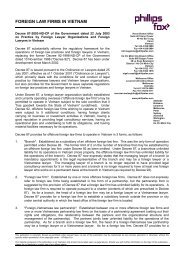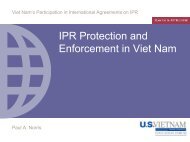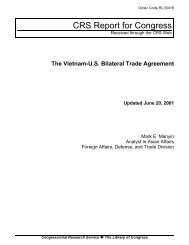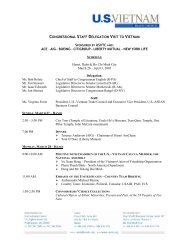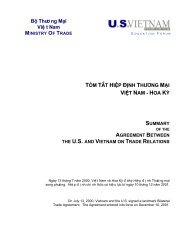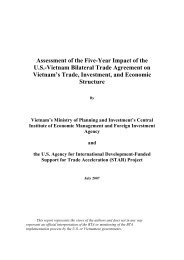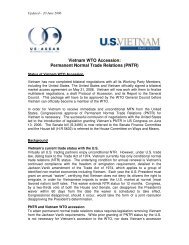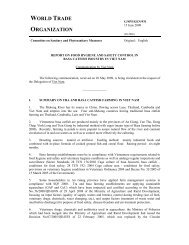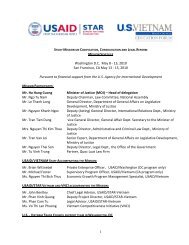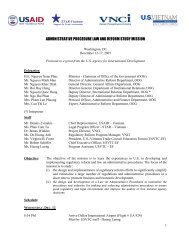Climate risks and adaptation in Asian coastal megacities: A synthesis
Climate risks and adaptation in Asian coastal megacities: A synthesis
Climate risks and adaptation in Asian coastal megacities: A synthesis
- No tags were found...
Create successful ePaper yourself
Turn your PDF publications into a flip-book with our unique Google optimized e-Paper software.
AnnexDComparison of Costsacross CitiesAn <strong>in</strong>terest<strong>in</strong>g question to ask is how climatechange costs compare across the different cities.The figure below provides a comparisonbetween the Manila <strong>and</strong> Bangkok case studies <strong>in</strong>the context of a 1-<strong>in</strong>-30-year flood. HCMC is not<strong>in</strong>cluded <strong>in</strong> this analysis because the methods forassess<strong>in</strong>g damage costs were very different. Thefigure below shows that <strong>in</strong> Bangkok, for <strong>in</strong>stance,the damages from a 1-<strong>in</strong>-30-year flood would<strong>in</strong>crease by almost 50 percent go<strong>in</strong>g from currentclimate to an A1FI climate change scenario, while asimilar flood <strong>in</strong> Manila will have a larger effect <strong>and</strong><strong>in</strong>crease costs by some 79 percent. However, whilethe Bangkok damage costs account for l<strong>and</strong> subsidence,the Manila costs do not. Thus, account<strong>in</strong>g forl<strong>and</strong> subsidence may make the <strong>in</strong>crease <strong>in</strong> costs <strong>in</strong>the two cities rather similar.The costs of climate change are accuratelymeasured as the costs <strong>in</strong> similar scenarios with <strong>and</strong>without climate change. Thus for Manila, the costsof climate change are represented by the differencebetween the 30-A1FI-EX <strong>and</strong> 30-SQ-EX scenarios.The costs for Manila from a 1-<strong>in</strong>-30-year flood are$0.67 billion, which amounts to 6 percent of its2008 GRDP. Similarly, the costs for Bangkok—thedifference between 2050-LS-SR-SS-A1FI <strong>and</strong> 2050-LS scenarios—amount to $1.47 billion, or 2 percentof Bangkok’s 2008 GRDP. Given that Bangkok is amuch wealthier city than Manila, these numbersare credible.How does HCMC st<strong>and</strong> <strong>in</strong> relation to the twocities? As previously noted, the costs to HCMC,because they are <strong>in</strong> present value terms <strong>and</strong> becauseof the different methodology used, are notcomparable to the estimates from Bangkok <strong>and</strong>Manila. However, to get a rough underst<strong>and</strong><strong>in</strong>g ofCompar<strong>in</strong>g Damage Costs <strong>in</strong> Bangkok<strong>and</strong> Manila80%70%60%50%40%30%20%10%0%72%49%Percent <strong>in</strong>crease<strong>in</strong> costs of 1/30flood due toclimate change15%9% 3% 5% 6% 2%Costs of 1/30flood as a % ofGRDP (withoutclimate change)Costs of 1/30flood as a % ofGRDP (with A1FIclimate change)Manila 2008 Bangkok 2008Additional costs ofclimate change asa % of GRDPwhether they are <strong>in</strong> the same order of magnitude,we annualize these costs. We f<strong>in</strong>d that annualequivalent of the damage costs to HCMC fallsbetween $0.67 <strong>and</strong> $5 billion, 62 which on the lowerend is comparable to the costs borne by Bangkok<strong>and</strong> Manila.62These numbers are the equal annual equivalents (EAE)(us<strong>in</strong>g a 10 percent discount rate <strong>and</strong> time period of 42years) of the present value of total costs from regular <strong>and</strong>extreme flood<strong>in</strong>g. The range reflects the m<strong>in</strong>imum <strong>and</strong>maximum present values of the two l<strong>and</strong> <strong>and</strong> GDP-basedestimations of climate change costs. EAE = NPV [(i(1 + i)n] / [(1 + i)n − 1)] where i=<strong>in</strong>terest rate <strong>and</strong> n=time period.97



